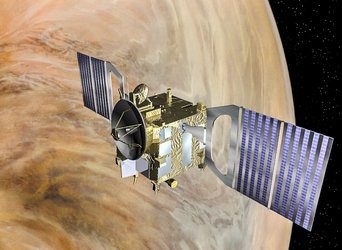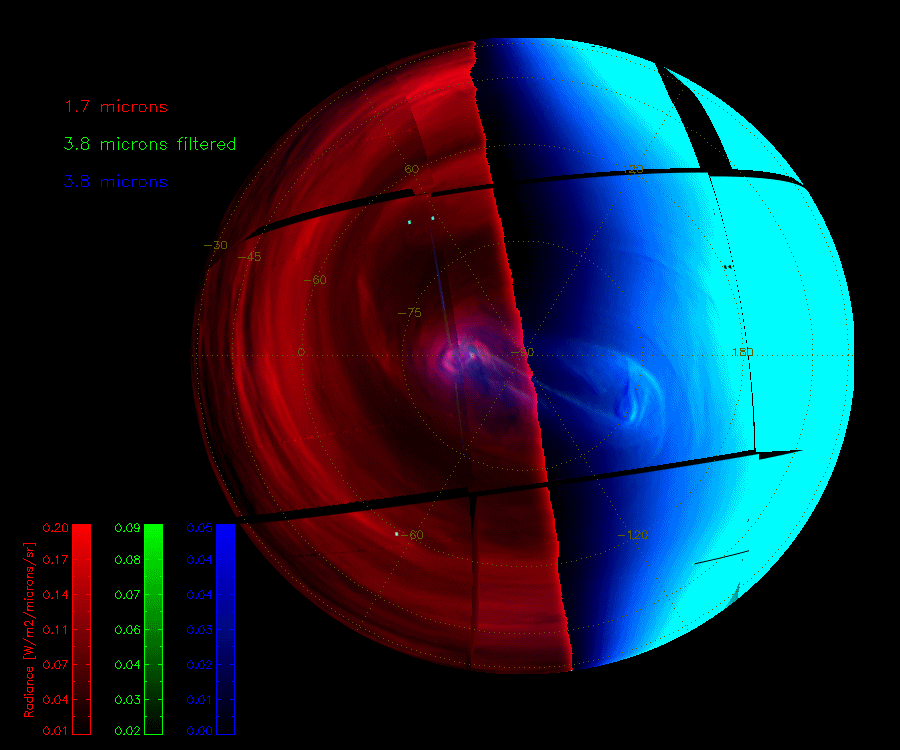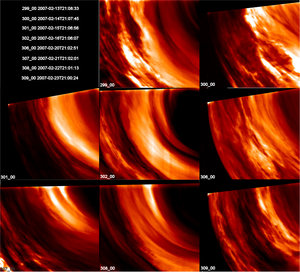The restless atmosphere of Venus
Venus Express has studied the true extent of Venus’s restless atmosphere. This includes the planet’s glow, its highly variable south polar vortex and the dynamic upper atmosphere, different from what is seen on any other rocky planet of the Solar System.
Venus’ faint glow of light coming from molecules in the atmosphere is providing scientists a detailed look into its physical and chemical processes.
The first triumph for Venus Express was to uncover the planet’s dramatic south polar vortex in unprecedented, fine detail. The vortex powerfully drives the cloud dynamics at all altitudes. “It plays an important role in balancing the atmosphere,” says Giuseppe Piccioni, VIRTIS co-Principal Investigator at IASF-Istituto Nazionale di Astrofisica, Italy, who used the Visible and Infrared Thermal Imaging Spectrometer (VIRTIS) instrument on Venus Express to discover and study the structure.

Planetary scientists believe that the double hurricane-like feature is formed when warm air from the equatorial regions of Venus rises into the atmosphere and travels down towards the pole of the planet. Once there, it begins to cool and sink, spiralling down to create the vortex.
Venus Express has also revealed new details about the turbulent region known as the ‘sub-solar’ region. This is the part of the planet that faces the Sun, which changes slowly as Venus rotates. It is the area of Venus that absorbs most of the incoming heat from the Sun, making it a crucial location for the atmospheric dynamics.

As the heat streams into the atmosphere, the gas breaks up into rolling pockets known as convection cells. “It is as if the whole region is boiling,” says Wojtech Markiewicz, VMC Principal Investigator at the Max-Planck-Institute for Solar System Research, Germany, drawing an analogy to the way milk boils in a pan.
Previous observations had hinted that the convection cells might be as large as 200 km across, but this was difficult to explain using conventional atmospheric physics. Venus Express observations clearly show that the cells are much smaller, about 20–30 km. At this size, the cells are probably confined to the mid-atmosphere, leaving a stable atmospheric layer below.
Venus has a high-altitude haze layer composed of brightly reflecting aerosol particles and a new mystery has been revealed. On 13 January 2007, under the gaze of Venus Express’s instruments, two thirds of the planet’s southern hemisphere suddenly brightened as something triggered the aerosols to form at a furious rate. As yet, no one knows what started this amazing transformation. The feature disappeared just as quickly a few days later when the aerosols had coagulated and the haze had cleared up.

Venus Express has also seen the glow from molecules of oxygen and carbon dioxide in the atmosphere of the planet. In the case of carbon dioxide, the ‘airglow’ is produced when the molecule absorbs and then re-emits a photon from the Sun. This happens quite quickly and the glow from carbon dioxide is confined to the day-side and low-pressure altitudes of the planet.
In contrast, the faint glow from oxygen has been detected from night side of the planet. This indicates a different mechanism at play. Indeed, the oxygen glows when two stray oxygen atoms join together, releasing some energy. Both types of emission tell scientists about the conditions in the atmosphere.
“The airglow allows us to constrain models of the atmosphere,” says Pierre Drossart, Observatoire de Paris, France, and the VIRTIS co-Principal Investigator. Already, the Venus Express results have allowed planetary scientists to adjust the temperatures in the atmosphere in their computer models to more realistic values.

Venus Express is certainly providing them.
Notes for editors:
The findings will appear in 29 November issue of the scientific journal Nature, in the following papers:
'A dynamic upper atmosphere of Venus as revealed by VIRTIS on Venus Express', by P.Drossart et al.
'South-polar features on Venus similar to those near the north pole', by G.Piccioni et al.
'Morphology and dynamics of the upper cloud layer of Venus', by W.Markiewickz et al.
Findings related to the study of the upper atmosphere will appear in the article:
‘The distribution of the 02 infrared nightglow observed with VIRTIS on board Venus Exppress’, by J-C. Gérard et al., accepted for publication in the Geophysical Research Letters.
For more information:
Giuseppe Piccioni, VIRTIS co-Principal Investigator, IASF-Istituto Nazionale di Astrofisica, Italy
Email: giuseppe.piccioni @ iasf-roma.inaf.it
Pierre Drossart, VIRTIS co-Principal Investigator Observatoire de Paris, France
Email : pierre.drossart @ obspm.fr
Wojtech Markiewicz, VMC Principal Investigator, Max-Planck-Institute for Solar System Research, Germany
Email: markiewicz @ mps.mpg.de
Håkan Svedhem, ESA’s Venus Express Project Scientist
Email: Hakan.Svedhem @ esa.int

















